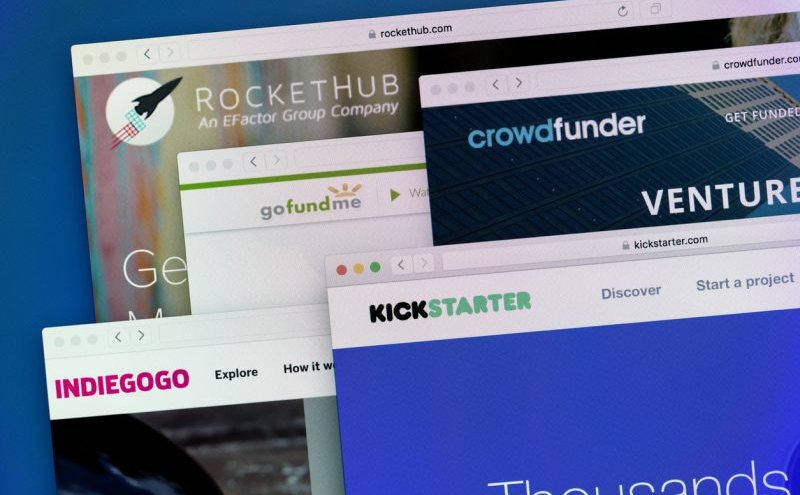Businesses willing to get creative are recognizing crowdfunding as an efficient way to raise money, market intelligently, and increase brand awareness, all in one seamless process.
Crowdfunding is a non-traditional means for rounding-up non-conventional investors and contributors. The primary definition of crowdfunding is that it is “a marketing strategy for raising money from a huge number of people who can contribute a small amount to your business or project.”
It works on the premise that you offer those contributors something in return, whether it be perks, products, or equity. The goal is to convince a large number of people to contribute in small amounts, and land a few mid-range to higher level contributors along the way, so you can generate the required capital within a short period of time.
Background
Though crowdfunding has existed in principle (even if not in name) throughout modern history, the current rendition of what we know as crowdfunding took off around 2009. In fact, “crowdfunding revenue tripled from $530 million in 2009, to $1.5 billion in 2011,” and has continued its rapid growth in the years since.
The appeal of crowdfunding has come largely from the fact that it “allows new projects and ventures to raise money, build brand awareness, and gather priceless feedback—all while still working on product and supply chain development. It also provides an open, honest avenue between businesses and backers, a rare commodity afforded to consumers today.”
The Basics
A successful crowdfunding launch will likely include some or all of the following steps, depending on what you already have in place:
- Researching your audience
- Picking the right platform
- Creating a website/landing page
- Creating a blog
- Creating useful networks on social media
- Issuing a press release
- Email marketing
There are multiple directions a crowdfunding campaign can go within each of these main areas, but the general process will likely echo this structure.
The Primary Players
Kickstarter, Indiegogo, and Fundable are a few of the most popular platforms for businesses looking to fund a project or idea. It will be helpful to visit each of the sites and find success stories in an area similar to your own. With a few of these in mind, you’ll be able to make a more informed choice on where and how to best spend your time.
Crowdsourcing
The great thing about engaging the crowd, is that even if you don’t have an idea or product to crowdfund, there’s a crowd solution for that: crowdsourcing.
Crowdsourcing is simply “the process of inviting ideas from groups – usually online — to solve a common problem.”
Both crowdfunding and crowdsourcing do two crucial favors to businesses in need of marketing help:
- Keeps them from developing in isolation, by engaging them with people who can help their company.
- Gets them engaged with the “right” people.
Most of the people businesses would be looking to target with traditional marketing means, advertising, and focus groups, are actually out there just waiting to promote their company for them, out of their own goodwill and enthusiasm, and not only that, but to like-minded friends and family.
The Psychology of the Crowd
There is something bold, brazen, and empowering about asking people for money – particularly when it’s as a way to get them and others to spend more money, spread word of mouth, and help your company after they’ve given you the money. This is in fact the whole basis of growth marketing, the idea that a number of loyal customers/fans are more than happy to do the viral work for you.
Even if you already have a lot of money, and people know it, it doesn’t seem to hurt the willingness of consumers to help back a crowdfunding effort, when it aligns with their other motivations.
In fact, “marketing as the primary reason for crowdfunding is gaining considerable traction with celebrities, fortune 500 companies, and venture-backed startups alike: those who can’t even pretend to be in financial binds worthy of public contribution.”
Additional Benefits of Crowdfunding
As illustrated on the TryCelery Blog, crowdfunding can also be used to:
- Receive product validation (or the opposite)
- Create brand advocates
- Have greater exposure (i.e. make the news, go viral)
- Become a beloved brand, which can be achieved by weaving storytelling into your campaign.
Any of these advantages on their own would be powerful, but combined with the other factors already mentioned it’s easy to see just how powerful crowdfunding can be.
Moving Forward
One huge advantage of this type of marketing, is that though there is a lot of noise from individual entrepreneurs and inventors, already successful businesses can often cut through this noise by leveraging their existing brand awareness.
As crowdfunding continues to rise as a both a monetary and a marketing platform, it will be a great opportunity for those on its leading edge, who are willing to embrace cultural shifts and make the most of the opportunities presented to them.
At Concepts Rise, we focus on technologies that are developed to increase revenues, lower costs, and impact the bottom line. We are passionate about information and believe that data analysis could provide insights into operations, sales, and marketing activities of a business. To learn more about our company and receive a consultation, please contact us today.
Majid Abai – June 2018 – Los Angeles
——————————————————-
About The Author:
Majid Abai is Managing Director of Concepts Rise (www.ConceptsRise.com), a High-Technology and Innovation Consultancy based in Los Angeles, CA, USA. With over 30 years of experience in supporting US and global organizations, Mr. Abai focuses on strategic and tactical approach to use of innovation and technology to increase revenues and reduce costs for organizations. Majid could be reached at 424-320-0524 or via email at majid.abai@ConceptsRise.com.
Tags: Crowdfunding, Crowdfund Marketing, Concepts Rise.

